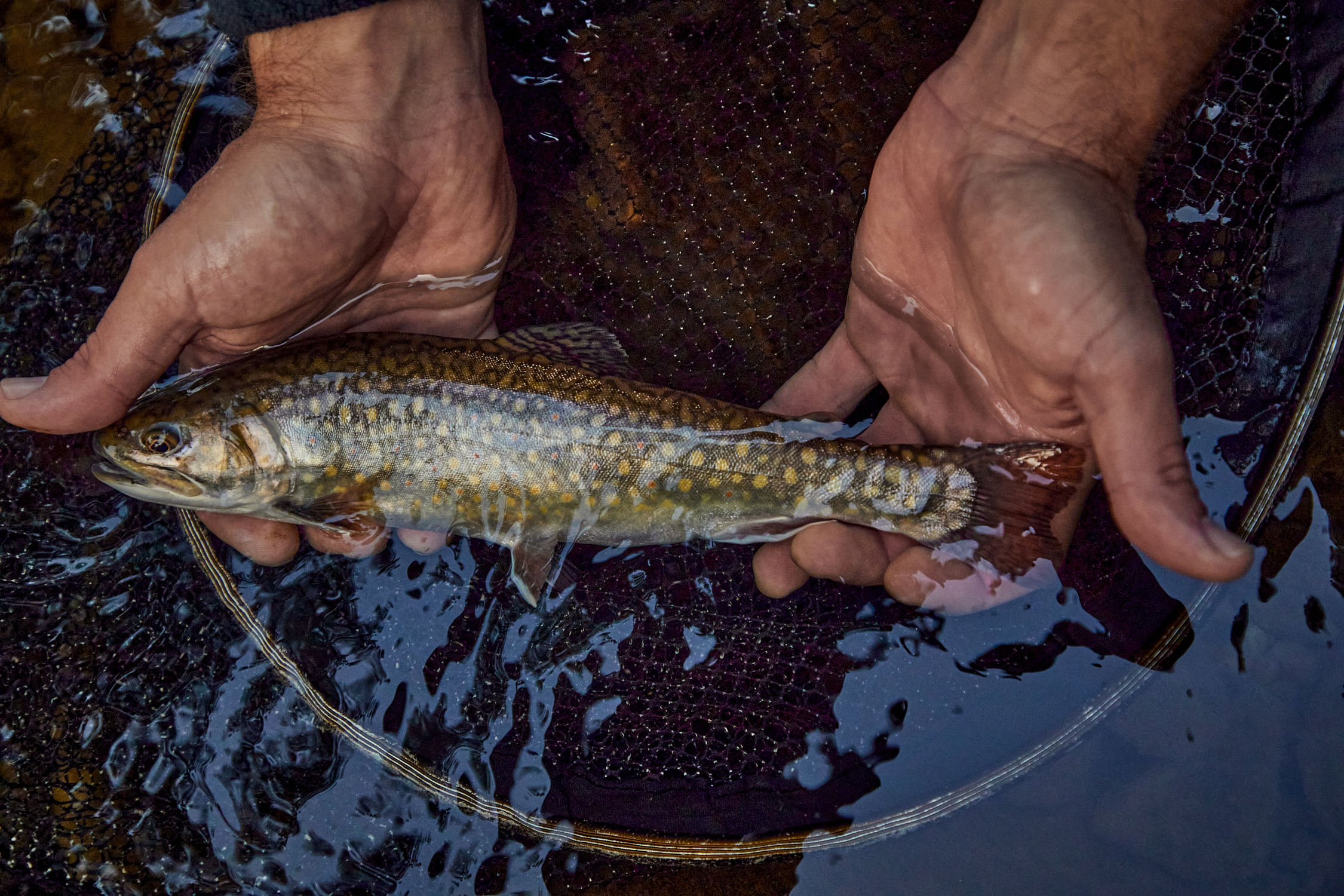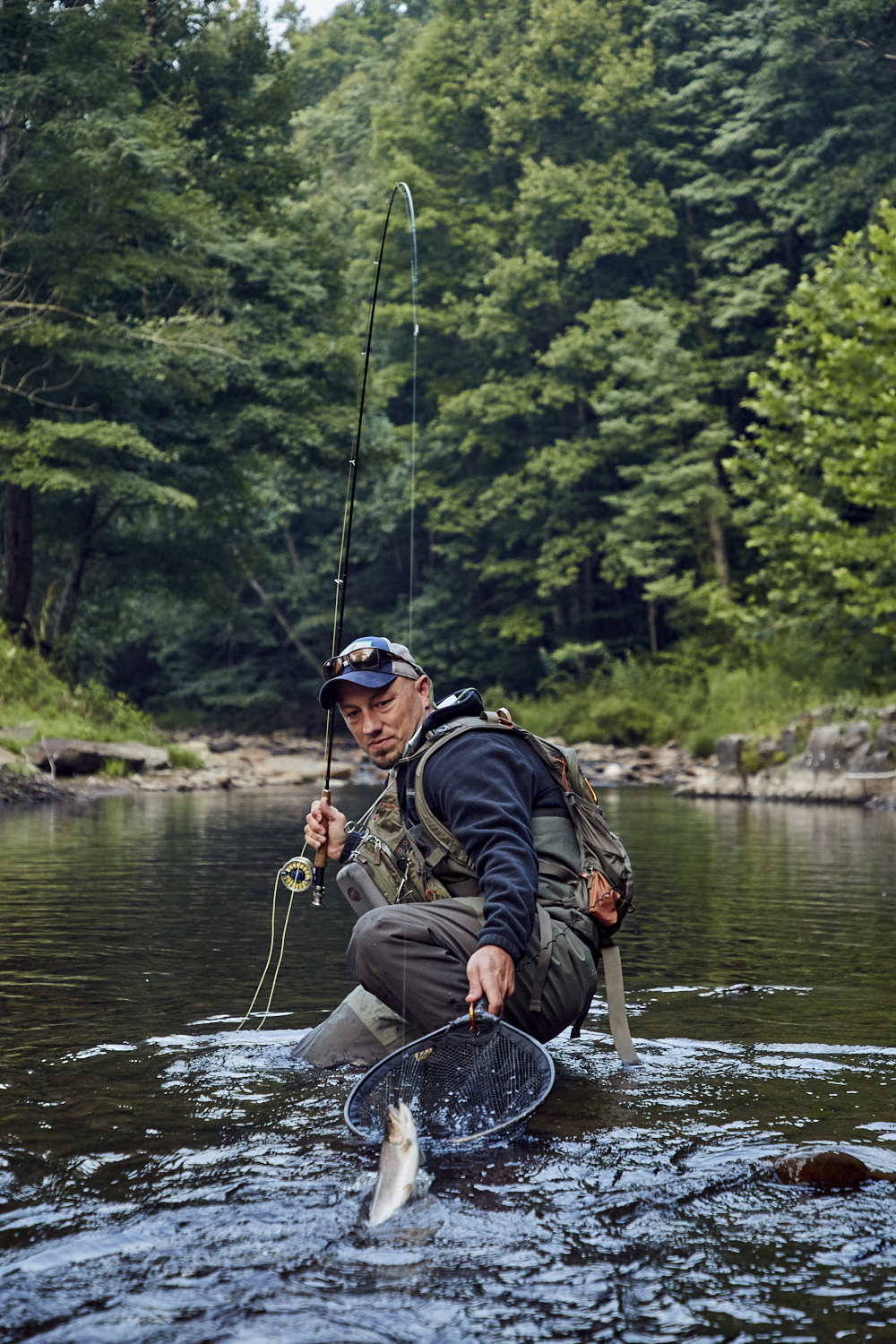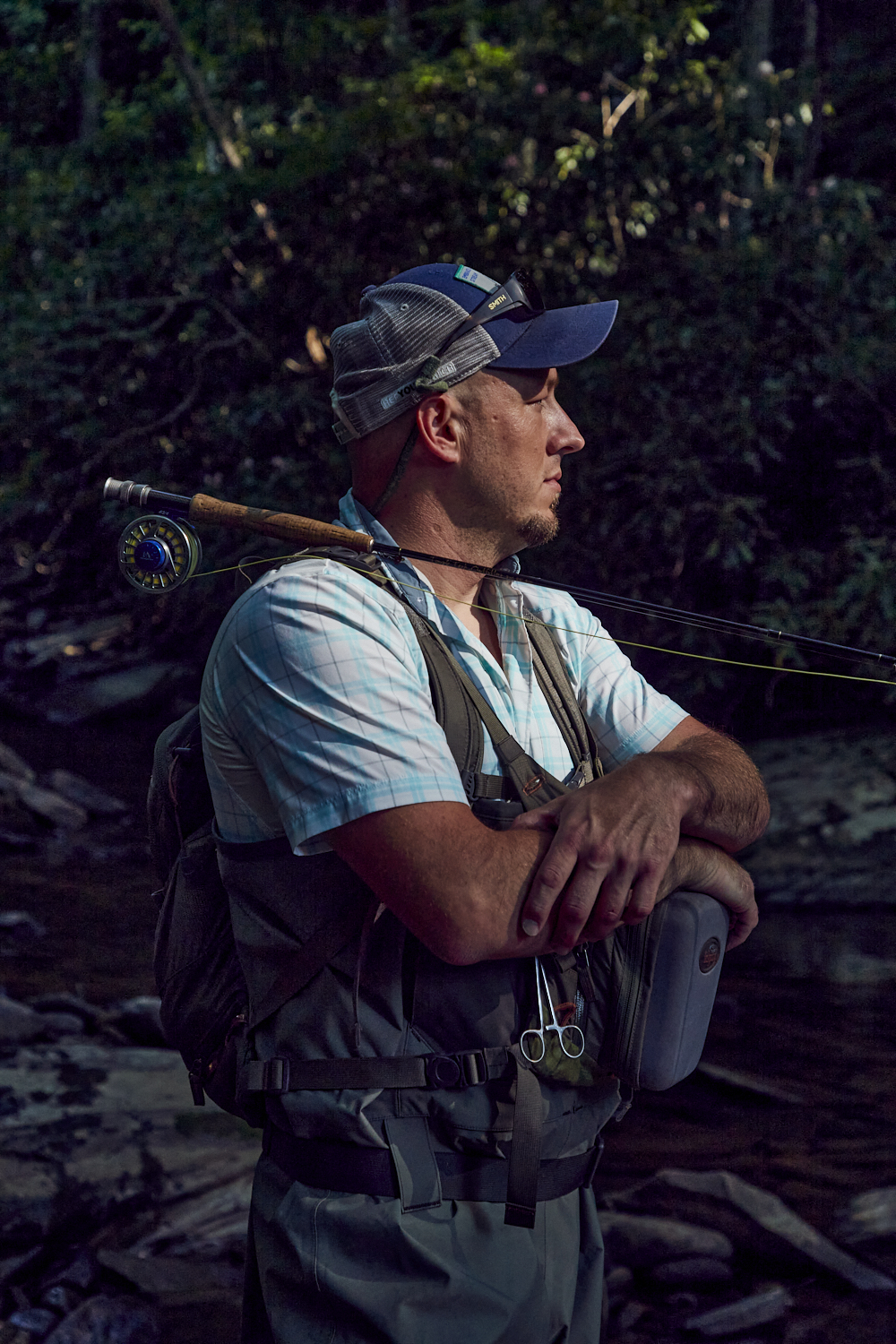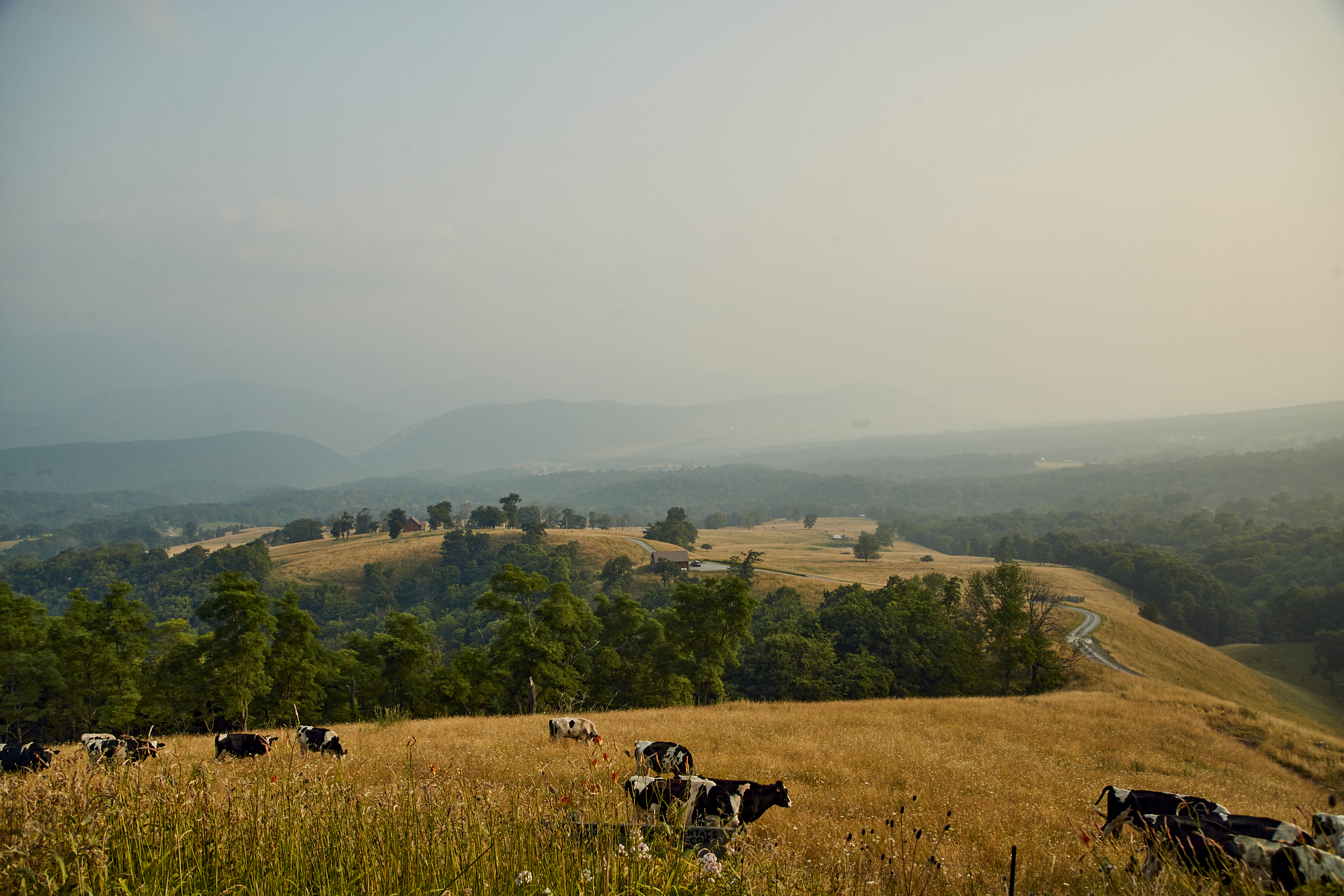Conservation
Return of the Native Brook Trout
On the back of a determined West Virginian—and private landowners and government agencies
alike—the vaunted and cherished brook trout just might be making a miracle comeback

Photo: William Hereford
A gorgeous brook trout just prior to release in the headwaters of the Potomac River.
A few miles into our hike up Big Run—a stream that hurries off the Allegheny Mountains in Pendleton County, West Virginia—Dustin Wichterman suddenly stops. “That one looks pretty fishy,” he says, pointing his handmade fly rod at a clear pool formed by some trees downed in the stream. Wichterman, who is thirty-five, steps off the bank and carefully wades into water that will—some 160 miles from here—eventually run by the Lincoln Memorial in Washington, D.C., on its way to the Chesapeake Bay. He glances back over his shoulder. Because of the deep summer canopy of this second-growth forest, he has no room for a backcast. So, with his rod in his right hand, Wichterman pinches his nymph fly between the forefinger and thumb of his left and pulls on the fly line, forming a taut arc in the rod, the classic “bow and arrow” cast that any true brook trout junkie must master. He closes one eye to sight his target, and then lets the fly go. It plops gently into the bathtub-sized pool and sinks for a second or two before a fish darts out from under the downed trees and snatches it. Wichterman reflexively strikes and quickly brings the eight-inch brook trout to his net. “Look at this beauty,” he says, beckoning me down from the bank.
As I gaze at this native fish—a product of one of the matrix of cold-water streams that compose this portion of the headwaters of the Potomac River—I’m reminded of Nick Karas’s most emphatic line in his seminal book about the species: “Brook trout are the prettiest fish in the world.” How could one disagree? The brook trout carries with it the colors of the great Eastern forest, in all of its seasons. Its green back is etched with vermicular markings. Yellow and red dots—some haloed in blue—speckle its flanks. Its lower fins are piped in pure white. In the fall before the spawn, its underbelly is brush-stroked in a blaze of orange.
Here in these ancient, beautiful, stoic Southern mountains, the brook trout also carries with it perhaps something even more significant, some sort of story about human sin and salvation. It carries with it the fall of Eden, but also the promise of redemption.
A year ago, it’s very likely that there weren’t any brook trout in this pool on Big Run. That’s because there was no “pool” to speak of in this spot. That there is one now is, in large part, because of Wichterman, a fisheries biologist who works for the conservation organization Trout Unlimited (TU).

Photo: William Hereford
Wichterman lands proof that his efforts are paying off.
Wichterman spearheads the on-the-ground work for TU’s restoration of the headwaters of the Potomac in the Eastern Panhandle of West Virginia, working with various federal agencies—like the National Resources Conservation Service and the Farm Service Agency—and private foundations to repair streams and improve habitat on both public and private land. Many of the streams in this area had been nearly destroyed, taken to the precipice of no return, thanks mainly to extensive logging and stream banks trampled by livestock. The forest around Big Run had been completely cut, and after some major floods, part of the lower reaches of its streambed was bulldozed and straightened, ostensibly to help mitigate the impact of future flooding. In reality, that type of unnatural stream reconstruction only exacerbates floods—and kills the stream in the process, widening its bed, stirring up silt, and making it lethally warm.
In 2020 on Big Run, Wichterman and TU, in partnership with the U.S. Forest Service, used grip hoists to place bundles of trees in strategic spots along the thirteen-mile river, aiming to create pools. Trees, of course, naturally fall across streams. “All we did was just help nature out a bit,” Wichterman says. The result, just one year later: cleaner, colder water, more protection from floods (the trees slow down the velocity of a swollen stream), and a significant increase in habitat for the native brook trout.

Photo: William Hereford
Dustin Wichterman surveys the work that he—in tandem with federal and private organizations—has done to improve brook trout habitat.
The Pilgrims at Plymouth Rock were among the first Europeans to lay eyes on brook trout, discovering them in streams as they searched for drinking water. The species (which is actually a char; it broke off from its close salmonid cousins, trout and salmon, some two to four million years ago) once thrived on the island of Manhattan before its creeks were irretrievably polluted and, later, completely paved over. Their native range extends as far north as Labrador, and west to Minnesota. But it is in Southern Appalachia—at the southernmost part of their range—that the brook trout, at once threatened and revered, has become perhaps most imbued in the region’s soul as the sentinel and heritage species. There are still native brookies in Georgia, South Carolina, Tennessee, Maryland, Virginia, West Virginia, and North Carolina. It is the official freshwater fish of the last three of those states.
Before industrialized logging, the fish numbered so many in the South that, according to Karas, a mountaineer once paid for his dental work with two hundred brook trout caught on the day of his appointment. But that plenitude came to a crashing end in the nineteenth century. Because of the mild weather in the Southern Appalachians, its vast forests of hemlock, firs, and spruce underwent virtually year-round logging, and the hillsides, with miles of nothing but stumps and mud, came to resemble the aftermath of Armageddon. Denuded of necessary canopy and used to transport countless logs, the streams became silted and warm. And the population of brook trout in the region declined precipitously, to the point that, for a time, they were considered for status as an endangered species. In response to that loss, well-intentioned officials stocked the streams with non-native brown (originally from Europe) and rainbow (originally from the American West) trout, and hatchery-raised brook trout from as far away as Massachusetts. But this only made things worse—the browns and the rainbows, which grew bigger and were better adapted to degraded water, pushed out the brookies. And interbreeding with their hatchery-raised brethren weakened their gene pool.
Still, remnant populations of native brook trout somehow hung on in various parts of the South (the locals could tell the difference between a hatchery-raised fish and a true native, and called the latter “speckled trout”), which gave conservationists hope for restoration. West Virginia may have offered the most promise. According to documentation from more than a century ago, the state was once a stronghold of brook trout abundance—and size. Many of the fish logged back in those days were in the twelve-to-fifteen-inch range, sizes now only seen in the northernmost parts of the species’ historical range. There is anecdotal evidence of some brook trout in the state reaching twenty inches. It is these big brookies—their restoration and possible proliferation—that Dustin Wichterman has dedicated his life to. “I really do believe that we can help these rivers and streams get back to a century or more ago to where you would routinely see this size fish,” he says. Why is that important? “These big fish are a symbol,an indicator of good, clean, swimmable, drinkable, and fishable water going all the way down to Chesapeake Bay.”
Wichterman has an easy smile and friendly blue eyes. Though he was born and raised in southern West Virginia, his roots—going back nine generations—are here in the headwaters of the Potomac. “This is where my heart and soul is,” he says. Nearly a decade ago, he saw a post for the job he currently has and “bugged TU until they finally hired me.” His degree in fisheries biology provides him with the knowledge needed for the technical aspects of the job, like how to identify where a stream needs rehabbing and then how to properly do the work. But it’s his skill in the other, less tangible part of the job that arguably matters more and has allowed him to thrive.

Photo: William Hereford
Views of the German Valley.
While some of Wichterman’s work takes place on public land—Big Run is in the Monongahela National Forest—the majority (around 60 percent) of it takes place on land that’s in private hands, which makes it more challenging. He has to first identify where streams need work—where, say, cattle have damaged the banks, where streamside trees have been cut down, or where low-water bridges have backed up the flow. And then comes the difficult part: Wichterman has to find out who owns the land and contact said owner—he often walks up and knocks on the door—and explain to them how some of their land practices are damaging the water that runs through their property and, in turn, damaging the property itself. He then asks if they will consider some rather drastic changes to their land, like planted trees, cattle exclusion fencing, and even new bridges. Most of the land in Pendleton County has been owned by families for many generations. The landowners can dislike change and be wary of outsiders—especially the government and government-like agencies.
His pitch includes a bit about the interconnectedness of the Potomac watershed, how the streams in these hills eventually join a river that provides drinking water for roughly twelve million people and that any pollution or siltation up here degrades the water in the Chesapeake Bay. But it’s the more straightforward, personal pitch that tends to work better, he says. “The work we do on their streams and rivers will actually help them improve their land and save their acreage from washing downstream.” And that restoration can take place, most of the time, at no cost to them (TU uses only federal and foundation money on private-land projects, and not its membership dues). A single project—say, new fencing or a new bridge—can cost between $50,000 and $100,000. Wichterman’s area of the Potomac headwaters project receives between $4 million and $6 million of funding annually.
The early years on the job were the toughest. He tried to grow a beard so that he looked older. “It was a bit of a struggle,” says Wichterman, who has now settled on a goatee. One landowner he met “looked like he wanted to punch me in the face.” But Wichterman persisted, and eventually, he got a single landowner to sign on to a project. That led to another and then created a snowball effect. “Folks around here love their land and intend to pass it on,” he says. “I feel like I’m just here to help them and, in doing so, help the fish.”

Photo: William Hereford
Brooklynn “Brookie” Wichterman cradles a brook trout alongside her father.
This approach has led to some dramatic successes. On one Pendleton County stream (he prefers it remain unnamed), he has worked with nearly all of the adjacent landowners, taking out culverts, replacing bridges, building fences, and planting ten thousand trees. The work has resulted in an explosion of the trout population (Wichterman periodically does electroshocking counts). “This stream is one of the most important brook trout nurseries in the entire Potomac watershed,” he says. “I really think this could be the one that produces the twenty-inchers. They might already even be here.”
On the North Fork of the South Branch of the Potomac—one of the bigger tributaries of the main river—a landowner named Lois Warner owns twenty-six acres on a mile of riverfront. Her family has owned the livestock and haying land for three generations. “I was initially hesitant when Dustin approached me with an idea to plant trees on the riverbank,” she says. “Any farm girl can tell you that you never give up any hay field. But we went back and forth and figured it out.” In 2017, Wichterman planted trees and placed boulders and root wads in the river to create cold-water pools. Warner is happy with the result. “It looks healthy and beautiful,” she says. (Wichterman has since attended her Fourth of July party.)
In all, Wichterman, TU, and their various partners have worked on four hundred farms, installed two million feet of fencing, and restored 150 miles of streams. “Dustin represents the best of the work we do,” says Chris Wood, TU’s president and CEO.

Photo: William Hereford
Father and daughter embrace a ray of light through the forest.
So many conservation stories are about despair, about the loss of species and habitat, about the human-led degradation of nature, about that loss of Eden. But what Wichterman is doing in this small part of West Virginia rings with hope. It’s about individual farmers and communities working together to help nature restore itself, about the optimism of working toward a better future. For Wichterman, this journey is personal. He is of the place (“He’s not some fast-talking guy from New Jersey, like me,” Wood says). He is fanatical about brook trout, those “small little miracles,” as Wood calls them, which live in only the coldest and cleanest water, and in only the most beautiful places. There is evidence that Wichterman’s dream of plentiful fish in the fifteen-inch range may be starting to come true—he’s caught a handful of them that big, though he’s still working on the twenty-incher. Wichterman named his daughter Brooklynn so he could call her “my little Brookie.” She is now six, and caught her first brook trout on a fly at age two, on a day Wichterman calls “one of the greatest of my life.” It is for her and her generation, in the end, that he is doing all of this work, so that they may experience something that was nearly lost and now just may be found again.







